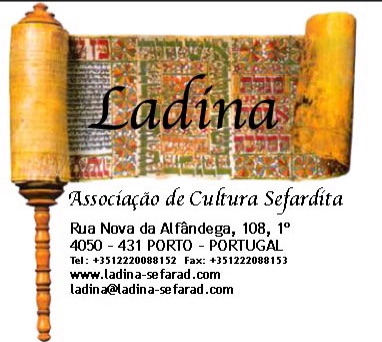(Municipal Museum/tower of Almedina)
Exposition and guided walking tours of Jewish Coimbra (Portugal's Oxford) includes:
-Exposition of Jewish culture in the Middle Ages through the use of graphics and objects.
-Jewish professions and economic activity.
-a Guided walking tour of the former Jewish neighbourhoods ("Judiarias") ending at the patio of the Inquisition.
-"The web of the Inquisition"-a guided tour.

Programa Pedagógico da exposição “Coimbra Judaica”
Museu Municipal | Torre de Almedina (Pátio do Castilho)
O programa pedagógico da exposição “Coimbra Judaica” foi definido em estreita
relação com as orientações curriculares e com os programas em vigor.
Procura complementar as propostas dos manuais assim como desenvolver hábitos
culturais nos alunos e criar-lhes o gosto pela aprendizagem, através do contacto com
os objectos reais que integram as exposições.
A metodologia de trabalho compreende, de acordo com os grupos etários, visitasguiadas, dinamização de ateliês, elaboração de fichas pedagógicas e um percurso
pedonal pelas judiarias de Coimbra que complementa a exposição.
Ateliê_ As Profissões!
Quais as profissões dos teus pais?
O que gostarias de ser quando fores grande?
Vem ter connosco à exposição “Coimbra Judaica” e ficarás a saber que algumas das
profissões que conheces já existem há muitos, muitos anos!
Público-alvo_ Jardim de Infância (a partir dos 4 anos)
Terça a sexta-feira_ Das 10h00 às 12h00 e das 14h00 às 17h00 (cadência regular de
1h)
Ateliê_ À Descoberta de Novas Culturas!
Sefer Tora, Hanukia e Mezuzah!
O que será?
!
Vem responder a estas e outras questões na exposição “Coimbra Judaica”
!
Público-alvo_ 1º Ciclo e ATL’s
Terça a sexta-feira_ Das 10h00 às 12h00 e das 14h00 às 17h00 (cadência regular de
1h)
Ateliê_ Judeu influente, perigo iminente!
A riqueza e instrução dos judeus sempre foi aproveitada pelo poder régio mas
simultaneamente mal interpretada pela nobreza e pelo povo.
Na exposição Coimbra Judaica ficarás a conhecer as vivências e a cultura judaica
percebendo o seu percurso ao longo da história.
Público-alvo_ 2º Ciclo
Terça a sexta-feira_ Das 10h00 às 12h00 e das 14h00 às 17h00 (cadência regular de 1h)
Programa_ As teias da Inquisição!
A Inquisição, tribunal da Igreja destinado a julgar os crimes contra a fé católica e os
bons costumes, foi criado no reinado de D. João III e teve como alvo preferencial os
judeus.
Na exposição “Coimbra Judaica” poderás conhecer melhor a dinâmica económicosocial e religiosa que influenciou a vivência medieval no burgo de Coimbra e as
adversidades daí decorrentes.
A reflexão que se propõe sobre este importante período da história pode ser
complementada com um percurso pedonal pelas judiarias de Coimbra terminando no
Pátio da Inquisição.
Público-alvo_ 3º Ciclo
Terça a sexta-feira
Visita-guiada_ Das 10h00 às 12h00 e das 14h00 às 17h00 (aprox. 40 min)
Percurso Pedonal (alternativo) _ Das 10h00 às 12h00 e das 14h00 às 17h00 (aprox. 1h30)
Programa_ A Cultura Judaica na Coimbra Medieval
A exposição “Coimbra Judaica” trata um tema não só de reconhecido interesse local e
regional mas também de âmbito nacional. A mostra patente na Torre de Almedina –
Núcleo da Cidade Muralhada, ilustra a história dos judeus, através de um registo
gráfico e objectual das suas vivências culturais e económicas desde a formação do
primeiro bairro judeu até à perseguição instaurada pelo Tribunal do Santo Oficio.
A reflexão que se propõe sobre este importante período da história pode ser
complementado com um percurso pedonal pelas judiarias de Coimbra terminando no
Pátio da Inquisição.
Público-alvo_ Ensino Secundário
Visita-guiada_ Das 10h00 às 12h00 e das 14h00 às 17h00 (aprox. 40 min)
Percurso Pedonal (alternativo) _ Das 10h00 às 12h00 e das 14h00 às 17h00 (aprox. 1h30)
Informações gerais
Disponível a partir do dia 28 de Outubro
Horário para marcações:
Segunda a Sexta-feira (Das 9h00 às 12h30 e das 14h00
às 17h30), através do contacto: 239 833 771
Número de inscrições: Min. 5 | Máx. 20
Gratuito




